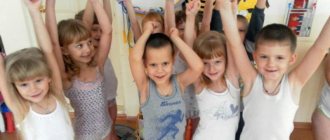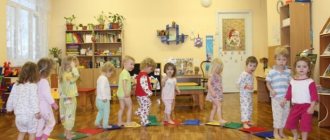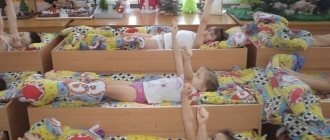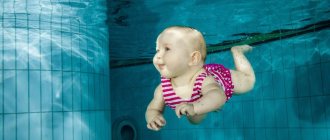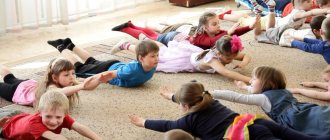Rules
Since the work is carried out with children, it is necessary to strictly adhere to these rules. Regularly ventilate the room in which children study. In the warm season, exercises are carried out in the fresh air. For exercises that are performed on the floor, you need to acquire special gymnastic mats.
Clothes and shoes for exercise should be practical and comfortable. There is a complete absence of synthetic fabrics; instead, natural, loose fit is recommended. Exercises should be carried out at the same time every day. This will develop a systematic approach and teach children responsibility and order. Follow the sequence of gymnastic exercises.
So that the classes do not seem monotonous and do not tire the child, periodically it is necessary to supplement the existing complex with something new. Children's exercises are not designed for strength training. Therefore, you need to choose movements aimed at developing flexibility, coordination and increasing tone. It is necessary to constantly monitor the child’s condition, avoiding holding his breath. It is worth completing the gymnastics before the child gets tired.
Carefully! Sudden jerky movements and quick rises from the bed are not allowed. This is fraught with dizziness, darkening of the eyes and stretching of rested muscles.
Hardening
Hardenings are carried out if they are developed and reinforced by the preschool educational institution program. At the same time, the methods should be individually focused on each student, taking into account the health characteristics of each child. If there are many children in a group and an individual program is not possible, the following moderate hardening technique is recommended.
Some of the active exercises in the summer are carried out outdoors; in the colder season, children perform gymnastics in a cool room (18–20 °C) without shoes, wearing T-shirts and panties. Health-improving walking barefoot on rubber massage mats is carried out, alternating with steps into basins of water. You can complete the gymnastics complex by washing your face, hands, neck, and chest.
Hardening trains the body's defenses, which will make the child less susceptible to changing environmental factors
In summer, dousing with water at room temperature is acceptable. Children will also benefit from dosed sunbathing during the warm period from 9:00 to 11:00. The time should gradually increase from 3 to 20 minutes.
Gymnastics for children 3-4 months old
In order to avoid repetition, we will add to the above exercises a description of new elements of gymnastics.
Breathing exercises
Starting position: on your back. Simultaneous movement of the arms up and down and circular movements with the arms are added.
Boxing exercise
Starting position: on your back. With your arms bent at the elbows, they are alternately straightened. The movements are reminiscent of boxing. Important! The handles are fixed in the wrist joints to prevent sprains.
Half-turns and turns from back to stomach and back
Starting position: on your back. One hand clasps the child's shins from below, the index finger of the adult's other hand is placed in the baby's palm, and the remaining fingers cover his hand. Then, slightly straightening the child’s legs, you should turn his pelvis, after which the child turns his head and shoulder girdle. Make turns in both directions in a similar manner.
Exercises on the ball
Starting from 3 months, you can introduce a new type of activity - exercises on the ball. For these exercises you will need a ball with a diameter of 50-60 cm, slightly deflated.
Swinging on the ball promotes the development of coordination, the vestibular apparatus, and helps to tone the abdominal muscles, back, and legs.
The baby is placed on the ball in different ways: on the back, on the tummy, and alternately on the sides.
Swings are performed with support on the legs, with legs raised.
It is important to remember to securely secure the child on the ball.
Card file of exercises for different blocks
The card file suggests breaking down the loads separately for each muscle group. Often, exercises are scheduled by month, after which an analysis of the work performed is carried out. Based on the latter, an analytical report is made based on the results of monitoring the physical measures taken. This analysis reflects:
- goals and objectives of gymnastics;
- indication of age group;
- the number of students involved in the exercises;
- number of hours allocated for classes;
- description of exercises taking into account their duration;
- responsible persons;
- period;
- results and recommendations.
The most effective and productive gymnastics after sleep in the preparatory group is as follows.
Exercises in bed
At the primary stage, muscles are warmed up after sleep. The bed blocks contain:
- “Stretching” – the arms are stretched along the body, giving way to stretching over the top of the head, while the legs are stretched towards the opposite side of the bed;
- “snake” - in a lying position, children roll from one side to the other, with their arms folded at the seams;
- “bicycle” - children raise their legs up and draw circles in the air, as if pedaling a bicycle;
- “stretching” - children take a sitting position and stretch their fingers to the toes of their evenly extended legs;
- “cat” - standing on their knees and hands, children alternate arching their back with arching it in the other direction;
- “wave” - sitting on their knees, the guys alternately sit on one side, then on the other, while their arms are also alternately directed in different directions.
An example of a visual performance of the “cat” exercise by kindergarten students
Active movements
Having finished warming up in bed, children move on to invigorating exercises:
- turns the head left and right, tilts in different directions, circular rotations;
- standing firmly on their heels, preschool children reach for the ceiling with their hands clasped together;
- standing on one leg, the toe of the bent leg touches the knee, while the hands are on the belt;
- turns and bends of the body;
- arms at your sides, legs shoulder-width apart - in this position, bend your torso, during which you move your arms back, you can make the “hissing” of the geese at this time to make the exercises more fun;
- walking in place turns into walking in a circle or in a line lined up one after another. Children walk alternately on the inside and outside of the foot; raise the leg bent at the knee forward; pulling the sock;
- after squats in place, they begin squats while walking: while squatting, children continue to move forward in this position;
- dynamic jumps with alternating legs (4 times on the right, 4 on the left, 4 on both) can be supplemented by stretching the knees, clapping for a certain count, alternating “low” jumps with “high” ones, etc.
To make it easier and more interesting for children to understand the essence of the exercises, they can be carried out in a playful way, accompanied by a musical background. During active exercise, you can allow the children to run after each other, walk on orthopedic rubber mats, and also practice with sports equipment. Organized walking of preschool children on orthopedic mats prevents flat feet and also develops fine motor skills of the toes.
Gymnastics for children 4-6 months
Unconditioned reflexes gradually fade away, so the proportion of passive-active exercises increases. The number of repetitions of the same exercise also increases.
Passive exercises are performed - flexion and extension in large joints.
Circular movements in the hip joints, with the obligatory fixation of the child’s knees with your own hands.
Simultaneous flexion - extension of the legs.
Starting position: on your back. You should grab the child's legs at the bottom of the lower leg from behind, holding the feet. Bend your legs at all joints, pressing them lightly towards your stomach (the baby's knees should be spread apart), then straighten the baby's legs.
Connection of opposite and identical knee-elbow.
The range of exercises on the ball is expanding.
At this age, many children swing with interest on the ball while lifting the toy from the surface.
On the ball in a position on the back, you can rock the baby with a slight “squat” when the legs reach support.
From 5 months, you can rock the baby on its side, pushing off the support surface.
Organization of gymnastics
All manipulations carried out with children must be carefully considered and comply with the Federal State Educational Standard (FSES) (federal state educational standards). This is a set of clear rules and requirements for education at a certain level. For the physical development of preschool children, there is a “Program for the training and education of preschool children,” which reflects the rules for conducting exercises for various groups, taking into account the age, physical and psychological development of children.
When organizing gymnastics, the teacher is guided by the following criteria:
- age;
- physical abilities of children;
- load distribution;
- complexity of exercises;
- duration;
- location.
Age
Taking into account this indicator, the set of exercises after lunch sleep differs. So, for younger children, exercises are carried out in a playful way, and the kids pretend to be birds, animals, and mother’s helpers. In this case, the teacher must complete each of the “exercises.”
In the preparatory group, children aged 5–6 years are more organized and independent, so the teacher can appoint the “eldest” child who will show the exercises to the whole group, and the rest of the children will repeat them. At this time, the teacher can devote time to individual work with specific children.
In the preparatory group, children remember the exercises performed daily, so they often practice doing warm-ups on their own.
Load distribution
A standard set of exercises is performed for 15–20 minutes. The distribution of the load is affected by curvature of posture, flat feet and other physiological problems. If there are none, the general scheme looks like this:
| Stage number | What to do | Description of the exercise | Duration (min.) |
| 1 | Arm and leg stretches | Performed in bed, immediately after waking up. You can continue the exercise in the form of alternate swings of arms and legs near the bed | 3 |
| 2 | Walking | The transition to the active phase continues with walking, from slow to gradually accelerating. You can start in a cool room | 3 |
| 3 | Active body movements | Movements to prevent problems of the musculoskeletal system are continued in a warm room. This can be active swings, bending, body turns, jumping, squats. It is recommended to supplement with sports equipment (skipping ropes, children's weights and dumbbells, etc.) | 5–7 |
| 4 | Breathing exercises | In a moderately cool room, exercise elements taken from breathing exercises | 3–4 |
Breathing exercises
An important part of awakening is correct breathing, which can be achieved using a number of special manipulations:
- clicking his tongue, parodying horses;
- active giggling;
- inflating a ball: a deep breath is followed by a uniform release of air, while children spread their arms to the sides, imitating inflating a ball; finish the exercise with a clap as a sign of the bursting of the balloon;
- dragon: active inhalations through the nose and exhalations through the mouth;
- snake: attempts to touch the tip of the nose and chin with the tongue;
- cow: exhalations should be smooth, measured, accompanied by a drawn-out “moo-oo”;
- steam locomotive: with their arms bent at the elbows, children walk one after another around the room (cars), while saying “chuh-chuh-chuh.”
All these exercises are aimed at strengthening and stimulating the respiratory tract, ensuring ventilation of the lungs.
